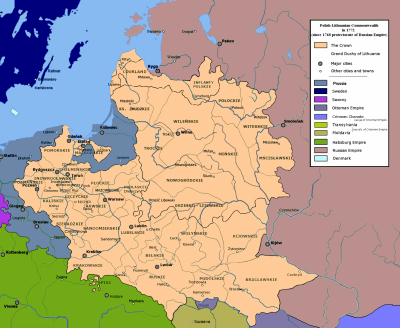Stanisaw II August (born Stanisaw Antoni Poniatowski; 17 January 1732 12 February 1798), known also by his regal Latin name Stanislaus II Augustus, was King of Poland and Grand Duke of Lithuania from 1764 to 1795, and the last monarch of the PolishLithuanian Commonwealth.
Born into wealthy Polish aristocracy, Poniatowski arrived as a diplomat at the Russian imperial court in Saint Petersburg in 1755 at the age of 22 and became intimately involved with the future empress Catherine the Great. With her connivance, he was elected King of Poland by the Polish Diet in September 1764 following the death of Augustus III. Contrary to expectations, Poniatowski attempted to reform and strengthen the large but ailing Commonwealth. His efforts were met with external opposition from neighbouring Prussia, Russia and Austria, all committed to keeping the Commonwealth weak. From within he was opposed by conservative interests, which saw the reforms as a threat to their traditional liberties and privileges granted centuries earlier.
The defining crisis of his early reign was the War of the Bar Confederation (17681772) that led to the First Partition of Poland (1772). The later part of his reign saw reforms wrought by the Diet (17881792) and the Constitution of 3 May 1791. These reforms were overthrown by the 1792 Targowica Confederation and by the PolishRussian War of 1792, leading directly to the Second Partition of Poland (1793), the Kociuszko Uprising (1794) and the final and Third Partition of Poland (1795), marking the end of the Commonwealth. Stripped of all meaningful power, Poniatowski abdicated in November 1795 and spent the last years of his life as a captive in Saint Petersburg's Marble Palace.
A controversial figure in Poland's history, he is criticized primarily for his failure to resolutely stand against and prevent the partitions, which led to the destruction of the Polish state. On the other hand, he is remembered as a great patron of the arts and sciences who laid the foundation for the Commission of National Education, the first institution of its kind in the world, and sponsored many architectural landmarks.
The Partitions of Poland were three partitions of the Polish–Lithuanian Commonwealth that took place toward the end of the 18th century and ended the existence of the state, resulting in the elimination of sovereign Poland and Lithuania for 123 years. The partitions were conducted by the Habsburg Monarchy, the Kingdom of Prussia, and the Russian Empire, which divided up the Commonwealth lands among themselves progressively in the process of territorial seizures and annexations.The First Partition was decided on August 5, 1772 after the Bar Confederation lost the war with Russia. The second partition occurred in the aftermath of the Polish–Russian War of 1792 and the Targowica Confederation of 1792 when Russian and Prussian troops entered the Commonwealth and the Second Partition was signed on January 23, 1793 (Austria did not participate in the Second Partition). The Third Partition took place on October 24, 1795, in reaction to the unsuccessful Polish Kościuszko Uprising the previous year. With this partition, the Commonwealth ceased to exist.In English, the term "Partitions of Poland" is sometimes used geographically as toponymy, to mean the three parts that the partitioning powers divided the Commonwealth into, namely: the Austrian Partition, the Prussian Partition and the Russian Partition. In Polish, there are two separate words for the two meanings. The consecutive acts of dividing and annexation of Poland are referred to as rozbiór (plural: rozbiory), while the term zabór (pl. zabory) means each part of the Commonwealth annexed in 1772–95 becoming part of Imperial Russia, Prussia, or Austria. Following the Congress of Vienna in 1815, the borders of the three partitioned sectors were redrawn; the Austrians established Galicia in the Austrian partition, whereas the Russians gained Warsaw from Prussia and formed an autonomous polity of Congress Poland in the Russian partition.
In Polish historiography, the term "Fourth Partition of Poland" has also been used, in reference to any subsequent annexation of Polish lands by foreign invaders. Depending on source and historical period, this could mean the events of 1815, or 1832 and 1846, or 1939. The term "Fourth Partition" in a temporal sense can also mean the diaspora communities that played an important political role in re-establishing the Polish sovereign state after 1918.

1795Nov, 25
Partitions of Poland: Stanisław August Poniatowski, the last king of independent Poland, is forced to abdicate and is exiled to Russia.
Choose Another Date
Events on 1795
- 19Jan
Republic of the Seven United Netherlands
The Batavian Republic is proclaimed in the Netherlands, bringing to an end the Republic of the Seven United Netherlands. - 28Mar
Duchy of Courland and Semigallia
Partitions of Poland: The Duchy of Courland and Semigallia, a northern fief of the Polish-Lithuanian Commonwealth, ceases to exist and becomes part of Imperial Russia. - 31May
Revolutionary Tribunal
French Revolution: The Revolutionary Tribunal is suppressed. - 17Jun
Dutch East India Company
The burghers of Swellendam expel the Dutch East India Company magistrate and declare a republic. - 25Nov
Stanisław August Poniatowski
Partitions of Poland: Stanisław August Poniatowski, the last king of independent Poland, is forced to abdicate and is exiled to Russia.

 English
English  español
español  français
français  português
português  русский
русский  العربية
العربية  简体中文
简体中文 